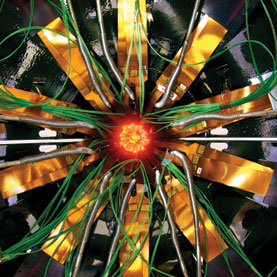|
Is Supersymmetry Dead?
The grand scheme, a stepping-stone to string theory, is still high on physicists' wish lists. But if no solid evidence surfaces soon, it could begin to have a serious PR problem
 For decades now physicists have contemplated the idea of an entire shadow world of elementary particles, called supersymmetry. It would elegantly solve mysteries that the current Standard Model of particle physics leaves unexplained, such as what cosmic dark matter is. Now some are starting to wonder. The most powerful collider in history, the Large Hadron Collider (LHC), has yet to see any new phenomena that would betray an unseen level of reality. Although the search has only just begun, it has made some theorists ask what physics might be like if supersymmetry is not true after all. For decades now physicists have contemplated the idea of an entire shadow world of elementary particles, called supersymmetry. It would elegantly solve mysteries that the current Standard Model of particle physics leaves unexplained, such as what cosmic dark matter is. Now some are starting to wonder. The most powerful collider in history, the Large Hadron Collider (LHC), has yet to see any new phenomena that would betray an unseen level of reality. Although the search has only just begun, it has made some theorists ask what physics might be like if supersymmetry is not true after all.
“Wherever we look, we see nothing—that is, we see no deviations from the Standard Model,” says Giacomo Polesello of Italy’s National Institute of Nuclear Physics in Pavia. Polesello is a leading member of the 3,000-strong international collaboration that built and operates ATLAS, one of two cathedral-size general-purpose detectors on the LHC ring. The other such detector, CMS, has seen nothing, either, according to an update presented at a conference in the Italian Alps in March.
Theorists introduced supersymmetry in the 1960s to connect the two basic types of particles seen in nature, called fermions and bosons. Roughly speaking, fermions are the constituents of matter (the electron being the quintessential example), whereas bosons are the carriers of the fundamental forces (the photon in the case of electromagnetism). Supersymmetry would give every known boson a heavy “superpartner” that is a fermion and every known fermion a heavy partner that is a boson. “It is the next step up toward the ultimate view of the world, where we make everything symmetric and beautiful,” says Michael Peskin, a theorist at SLAC National Accelerator Laboratory.
The monumental collider at CERN near Geneva should have the oomph to produce those superparticles. Currently the LHC is smashing protons with an energy of four trillion electron volts (TeV) apiece, up from 3.5 TeV last year. This energy is divided among the quarks and gluons that make up the protons, so the collision can generate new particles with the equivalent of about 1 TeV of mass. But despite the high expectations (and energies), so far nature has not cooperated. LHC physicists have been searching for signs of particles new to science and have seen none. If superparticles exist, they must be even heavier than many physicists had hoped. “To put it bluntly,” Polesello says, “the situation is that we have ruled out a number of ‘easy’ models that should have showed up right away.” His colleague Ian Hinchliffe of Lawrence Berkeley National Laboratory echoes him: “If you look at the range of masses and particles that have been excluded, it’s quite impressive.”
Many are still hopeful. “There are still very viable ways of building supersymmetry models,” Peskin says. Expecting to see new physics after just a year of data taking was unrealistic, says Joseph Lykken, a theorist on the CMS team.
What has theorists on edge, however, is that for supersymmetry to solve the problems for which it was invented in the first place, at least a few of the superparticles should not be too heavy. To constitute dark matter, for example, they need to weigh no more than a few tenths of 1 TeV.
Another reason most physicists want some superparticles to be light lies in the Higgs boson, another major target of the LHC. All elementary particles that have mass are supposed to get it through their interaction with this boson and, secondarily, with a halo of fleeting “virtual particles.” In most cases, the symmetries of the Standard Model ensure that these virtual particles cancel one another out, so they contribute only modestly to mass. The exception, ironically, is the Higgs itself. Calculations based on the Standard Model yield the paradoxical result that the boson’s mass should be infinite. Superpartners would solve this mystery by providing greater scope for cancellations. A Higgs mass of around 0.125 TeV, as suggested by preliminary results announced in December 2011, would be right in the range where supersymmetry predicts it should be. But in that case, the superparticles would need to have a fairly low mass.
Source: Scientific American Magazine
25/04/2012
|